Notes
- ↑ Wilson, Peter H. (2016). The Holy Roman Empire. Allen Lane.
Henry I | |
|---|---|
| Archbishop of Trier | |
| Church | Catholic Church |
| Diocese | Electorate of Trier |
| In office | 956–964 |
| Personal details | |
| Died | 3 July 964 |
Henry I (died 3 July 964) was the Archbishop of Trier from 956 until his death.
Henry was a member of the Popponids (Elder House of Babenberg). His brother was Poppo I, Bishop of Würzburg, and another possible brother was the Berthold of Schweinfurt. Henry was trained with Wolfgang, the future saint and Bishop of Regensburg, in the Abbey of Reichenau. Henry and Wolfgang were later trained at the cathedral school in Würzburg by Stephen of Novara. In 956, Otto I of Germany appointed Henry to the vacant see of Trier.
On 26 May 961, Henry with the archbishops Bruno I of Cologne and William of Mainz crowned Otto's son Otto II king. Henry later accompanied Otto I on his campaigns in Italy. He died in Rome during an epidemic of malaria that broke out in the imperial army caused by nearby pestilent marshes. [1] Henry was buried in Parma but his remains were later translated to Trier Cathedral.
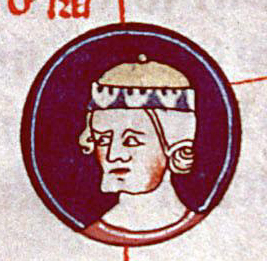
Hugh the Great was the duke of the Franks and count of Paris. He was the most powerful magnate in France.
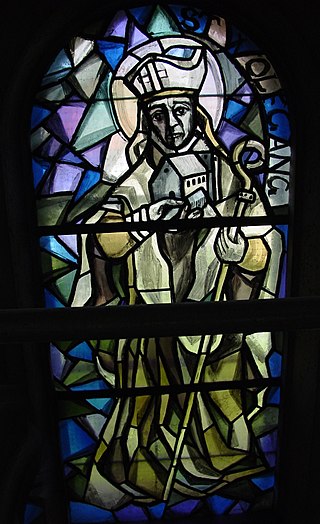
Wolfgang of Regensburg was bishop of Regensburg in Bavaria from Christmas 972 until his death. He is a saint in the Catholic and Eastern Orthodox churches. He is regarded as one of the three great German saints of the 10th century, the other two being Ulrich of Augsburg and Conrad of Constance. Towards the end of his life Wolfgang withdrew as a hermit to a solitary spot, in the Salzkammergut region of Upper Austria. Soon after Wolfgang's death many churches chose him as their patron saint, and various towns were named after him.

Leopold I, known as the Illustrious was a member of the House of Babenberg who ruled as Margrave of Austria from 976 until his death. He was the first margrave of the Babenberg dynasty which ruled the March and Duchy of Austria until its extinction in 1246.

Bruno the Great was the archbishop of Cologne from 953 until his death and the duke of Lotharingia after 954. He was the youngest brother of Emperor Otto I.

The House of Schönborn is the name of an ancient noble and formerly sovereign family of the Holy Roman Empire. As a former ruling and mediatized family, it belongs to the Hochadel.

Johann Philipp von Schönborn was the Archbishop-Elector of Mainz (1647–1673), the Bishop of Würzburg (1642–1673), and the Bishop of Worms (1663–1673).
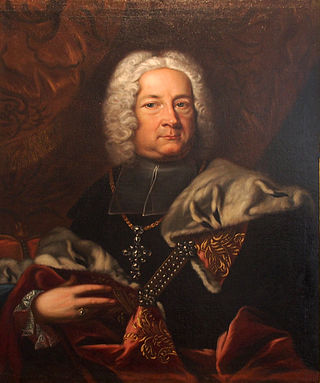
Friedrich Karl von Schönborn was the Prince-Bishop of Würzburg and Prince-Bishop of Bamberg from 1729 to 1746. He also served as Reichsvizekanzler (Vice-Chancellor) of the Holy Roman Empire from 1705 to 1734.
Henry II "the Rich" of Nassau was Count of Nassau. He distinguished himself in particular by his chivalrous and devout spirit. He was charitable and made great donations to the church, so that the monasteries and prayer houses in the area of present-day Nassau experienced the most significant bloom in his time. The greatest favour was the Teutonic Order to enjoy, to which he donated especially for the renunciation of his brother's, upon his entry into the order. Henry participated in the Sixth Crusade. He was the builder of the castles Sonnenberg, Ginsburg and Dillenburg.
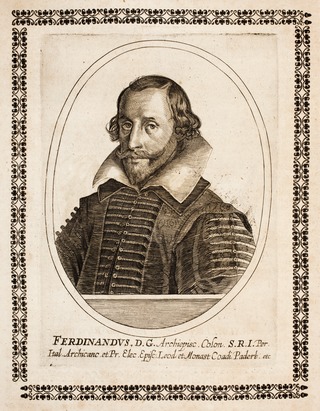
Ferdinand of Bavaria was Prince-elector archbishop of the Archbishopric of Cologne from 1612 to 1650, as successor of Ernest of Bavaria. He was also prince-bishop of Hildesheim, Liège, Münster, and Paderborn.

The Prince-Bishopric of Bamberg was an ecclesiastical State of the Holy Roman Empire. It goes back to the Roman Catholic Diocese of Bamberg established at the 1007 synod in Frankfurt, at the behest of King Henry II to further expand the spread of Christianity in the Franconian lands. The bishops obtained the status of Imperial immediacy about 1245 and ruled their estates as Prince-bishops until they were subsumed to the Electorate of Bavaria in the course of the German Mediatisation in 1802.

Egbert was the Archbishop of Trier from 977 until his death.
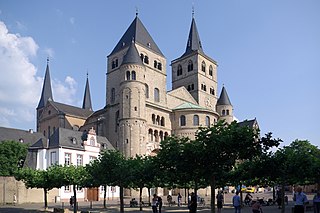
The Diocese of Trier, in English historically also known as Treves from French Trèves, is a Latin Church ecclesiastical territory or diocese of the Catholic church in Germany. When it was the archbishopric and Electorate of Trier, it was one of the most important states of the Holy Roman Empire, both as an ecclesiastical principality and as a diocese of the church. Unlike the other Rhenish dioceses—including Mainz and Cologne–Trier was the former Roman provincial capital of Augusta Treverorum. Given its status, Trier has continuously been an episcopal see since Roman times and is one of the oldest dioceses in all of Germany. The diocese was elevated to an archdiocese in the time of Charlemagne and was the metropolitan for the dioceses of Metz, Toul, and Verdun. After the victory of Napoleon Bonaparte of France, the archdiocese was lowered to a diocese and is now a suffragan in the ecclesiastical province of the Archdiocese of Cologne. The diocesan cathedral is the Cathedral of Saint Peter. The Cathedral Chapter retains the right to elect the bishop, rather than selection by papal appointment.
The Conradines or Conradiner were a dynasty of Franconian counts and dukes in the 8th to 11th Century, named after Duke Conrad the Elder and his son King Conrad I of Germany.
Johann von der Leyen was a German clergyman who served as Archbishop and Elector of Trier from 1556 until his death in 1567.
The Poppinids were an Frankish dynasty flourising in the early 9th century that originated from Grabfeld. They are named after their descent from Poppo of Grapfeld, who in turn descended from the Robertians. The Popponids gradually evolved into the Elder House of Babenberg. They were related to the Luitpoldings.

Theoderich von Wied was Archbishop and Prince-elector of Trier from 1212 until his death.
A royal election was held in the Kingdom of Germany after the death of childless Emperor Otto III. It was won by Duke Henry IV of Bavaria among accusations of uncustomary practices.

Robert, also spelled Ruotbert or Rotbert, was the archbishop of Trier from 931 until his death. He played a leading role in the politics of both Germany and France, and especially of the Lotharingian territory in between. He was a patron of scholars and writers and a reformer of monasteries.
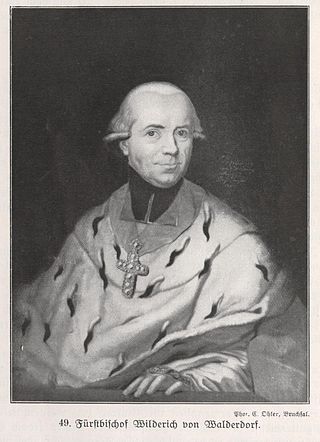
Wilderich Freiherr von Walderdorff from the Walderdorff family was Prince-Bishop of Vienna and Reichsvizekanzler (Vice-Chancellor) of the Holy Roman Empire (1660–1669).

Arnold II of Isenburg was Archbishop of Trier from 1242 to his death. A long-time member of the cathedral chapter in Trier, he held several provostships before being elected as archbishop, succeeding his uncle Theoderich von Wied. The election was controversial, and king Conrad IV of Germany granted the regalia to Rudolf de Ponte, the opposing candidate, instead. A short military conflict ensued, and the dispute ended after Rudolf's death when Arnold was confirmed as archbishop by Pope Innocent IV and consecrated in 1245.